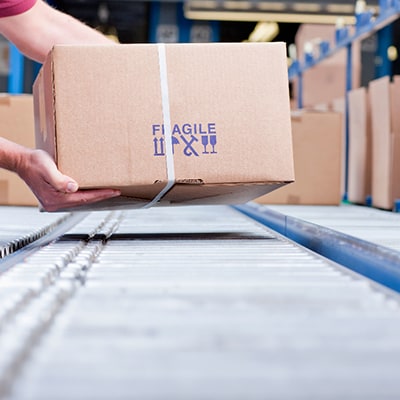Understanding risk management in the supply chain has been saved

Perspectives
Understanding risk management in the supply chain
Using supply chain data analytics to drive performance
A business is only as strong as the chain of suppliers it works with. So leaders must recognize and work to understand the factors that promote strong risk management in the supply chain. Ensuring that your goods arrive on time is only a piece of the whole. Managing vendor relationships, building strong payment protocols, and knowing the geographic challenges associated with growth can help keep risks under control. See our five steps to supply chain risk management—to help you gain competitive advantage, protect your brand, and drive growth.
Explore content
- Managing risk from beginning to end
- Proactive risk management
- 1. Get to know your potential suppliers
- 2. Make sure you get what you’ve asked for
- 3. Only pay for what you’ve actually received
- 4. Prevent or resolve disputes effectively
- 5. Avoid risks in the sales process
- Mitigate risk and create value
- Supply chain risk mitigation services
- Get in touch
- Join the conversation
Managing risk from beginning to end
Risk management in the supply chain has become increasingly important as companies both large and small seek to extend their global reach. Enterprises entering new markets often need to form new supplier relationships, engage with state-owned entities, and adapt to local laws and culture. The resulting complexity in the supply chain can mask a wide range of financial, regulatory, and legal risks.
Truly understanding the supply chain requires stringent processes and capabilities for supply chain data analytics. “Many companies are using data analytics to look at not just financial transaction information, but also other more operational details to really understand where their potential risks lie,” says Larry Kivett, a Deloitte Risk and Financial Advisory partner in the Forensic practice of Deloitte Financial Advisory Services LLP. Indeed, the complexity of today’s environment has made the use of supply chain data analytics critical for identifying supply chain waste, fraud, billing anomalies, and risk patterns.
Proactive risk management
In this context, it’s not surprising that supply chain waste and disruptions arising from fraud and abuse have become more common. A recent Deloitte Touche Tohmatsu Limited survey found that 85 percent of surveyed global supply chains had experienced at least one disruption in the past 12 months. Fortunately, proactive risk management in the supply chain has shown to be a cost-effective approach. Companies that indicated that they proactively manage supply chain risk spend 50 percent less to manage supplier disruptions than companies that stated that they aren’t proactive.
As your company makes strategic choices, such as expanding geographic reach and taking on the related risks, you need to effectively manage risk from beginning to end. This mindset can help your organization gain competitive advantage, maintain your brand’s reputation, and ultimately, use an understanding of risk to drive performance.
Here are five steps that can help you proactively manage supply chain risk:

1. Get to know your potential suppliers
An effective due-diligence process answers critical questions about a third-party’s business practices. For example: Does it have a strong track record for meeting contractual obligations? Do existing business relationships create any conflicts of interest? Does it observe the same high standards as your company with respect to providing safe working conditions and protecting the environment?
Be sure to consider whether your existing supply network can meet your needs before deciding to bring on a new supplier. Forming strategic partnerships with a select group of your best suppliers can allow you to capture a wide variety of benefits—including the potential for scale advantages and priority service.

2. Make sure you get what you’ve asked for
Carefully monitor the goods and services you’re receiving to ensure that the quality and quantity strictly adhere to the requirements set out in your contract with the supplier. Despite your best efforts related to due diligence, you may find yourself working with a supplier that provides goods or services that are inferior to what your contract calls for. Needless to say, getting what you’ve asked for makes it much easier to meet your own high standards for the products or services you offer to your customers.

3. Only pay for what you’ve actually received
Your accounts-payable processes should equip you to ensure that a supplier’s invoice corresponds precisely to the goods or services you’ve actually received. Having a complex network of contractors can increase the risk of duplicate billing, inappropriate markups, and improper related-party billing. “There's always the risk that, once the vendor has been vetted and allowed into the system, something potentially can go wrong,” says Kivett. In a recent Deloitte poll of 2,660 corporate professionals, 29 percent of respondents indicated that their company had experienced supply chain waste, fraud, or abuse in the past 12 months.
A healthy skepticism among the accounts-payable staff can go a long way toward protecting you. Staff members should regard themselves as “stewards of the company’s cash,” rather than merely “volume producers,” says Mark Pearson, a Deloitte Risk and Financial Advisory principal in the Forensic practice of Deloitte Financial Advisory Services LLP. A well-functioning process for review and escalation can drive value throughout your organization and instill a mindset that accuracy and attention to detail matter.

4. Prevent or resolve disputes effectively
Disputes are inevitable at each stage of the supply chain. One key to mitigating dispute-related risks and promoting smooth operations is to proactively prevent disputes from occurring or resolve them amicably if they happen. The right processes and technologies are essential for identifying sources of disagreement that might disrupt the supply chain. “You need to have people with the right communications skills and ability to not affect ongoing supply of material,” says Pearson. A mutually beneficial resolution is often the best way to maintain a relationship that not only mitigates risk but also enhances value for your company.

5. Avoid risks in the sales process, too
Companies should also be attuned to the risks that arise from sales operations. Your sales operations are a crucial link in a loop that returns to your suppliers, because customer demand ultimately affects your purchasing requirements. “As [the sales channel] morphs or evolves, it can introduce new risks into the environment,” says Kivett. “For instance, if you're a company that opens up a new market and you're moving into a geography that you haven't previously provided goods or services into, that's going to change the procurement-supply dynamic,” he explains.
To address this risk, you must understand the liability that sales interactions expose your company to. Sales are the lifeblood of your company, so the motto “do no harm” should guide efforts to drive higher revenue growth.

Mitigate risk and create value
Creating value in your supply chain while simultaneously mitigating risks to your company requires a coordinated effort between multiple stakeholders in the business, including supply chain and procurement personnel, legal, compliance, and finance. Vetting potential third-party relationships is a critical first step to mitigating risk to your organization, but it’s only a first step. By working together across the business, these various stakeholders can design a strategy for using third-party relationships to increase value within the supply chain. Companies that succeed can both protect their brands and drive business growth.
Prefer to read the article in PDF format? Download Understanding risk management in the supply chain: Using supply chain data analytics to drive performance.

Supply chain risk mitigation services
Deloitte's Forensic team advises clients on ways to mitigate their reputational exposure to supply chain breakdowns, global corruption, financial crime, enterprise fraud, cybercrime, and other vulnerabilities. Our professionals anticipate emerging threats through the use of market-leading technology to uncover possibilities that others may fail to find, and they help clients turn business issues into opportunities for growth, resilience, and long-term advantage.
Learn more about Deloitte's Risk and Financial Advisory's Forensic solutions.
open in new window Contact the forensics teamExplore content
- Managing risk from beginning to end
- Proactive risk management
- 1. Get to know your potential suppliers
- 2. Make sure you get what you’ve asked for
- 3. Only pay for what you’ve actually received
- 4. Prevent or resolve disputes effectively
- 5. Avoid risks in the sales process
- Mitigate risk and create value
- Supply chain risk mitigation services
- Get in touch
- Join the conversation
Recommendations
The future of risk: Ten trends
New game, new rules
Cognitive computing applications for risk management
Better decision making with artificial intelligence


